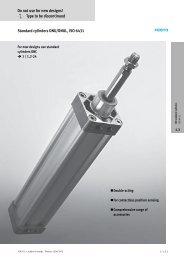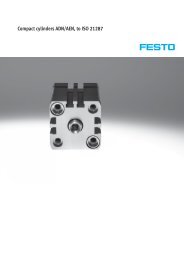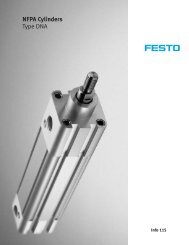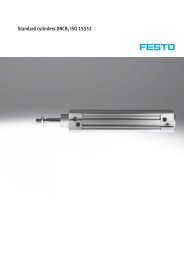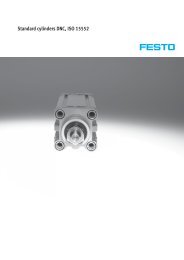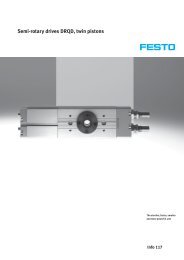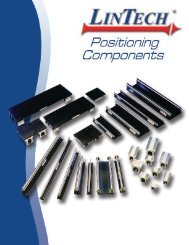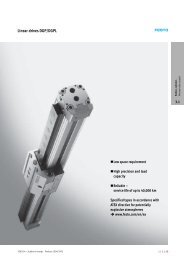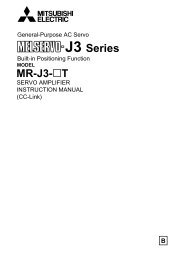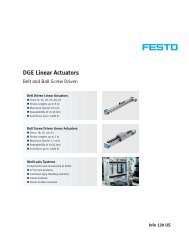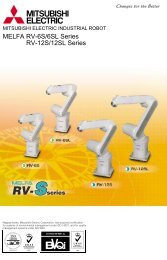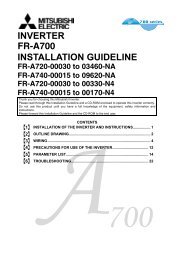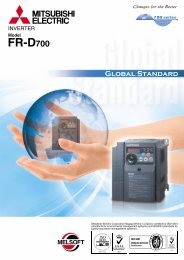RFID Systems - Allied Automation, Inc.
RFID Systems - Allied Automation, Inc.
RFID Systems - Allied Automation, Inc.
You also want an ePaper? Increase the reach of your titles
YUMPU automatically turns print PDFs into web optimized ePapers that Google loves.
<strong>RFID</strong> <strong>Systems</strong>Fundamentals of <strong>RFID</strong>FrequenciesThere are many frequency ranges available. They can all begrouped under the same <strong>RFID</strong> umbrella. Each frequency hasits advantages and industries where it is often used. Thereare 3 major frequency bands available: low frequency125/250 kHz, high frequency 13.56 MHz, and ultra-highfrequency 2.45 GHz.125 and 250 kHzThe low frequency systems typically have a few inches ofread range, are highly immune to metal in the environmentand have good field penetration of water, grease and othernonmetallic substances. The wound coil required in a lowfrequency system makes the tag moderately expensive andtypically requires the tags to be reusable and not disposable.This frequency range is ideal for factory automation, toolidentification, closed loop parts tracking, animal tracking andinventory control.Applications:AGVs – In an automotive plant an AGV (Automated GuidedVehicle) often moves parts into position. The ID tag is locatedon the floor every few feet and the reader is on the vehicle.The AGV determines location by the most recent tag read.Paint – Bodies are tracked during the paint process. Specialhigh temperature tags are used to withstand this abusive andcaustic environment.Sequence Verification – The just-in-time transfer of parts fromTier 1 suppliers to assembly plants requires that the deliveredparts are in order. Any sequence deviation will sound an alarmand the problem can be corrected.Parts Assembly – The raw parts are assembled on a fixtureand the fixture is tracked from one station to the next. Eachstation has a read head that verifies which operations areperformed and sets pass/fail bits that are checked at the endof the production line.Access Control – Often a user will carry a key fob tag oraccess card that is carried to access doors. The tag will verifyentrance into the facility.Crane Positioning – When moving product, a crane ispositioned based on an X/Y coordinate system. The tag ismounted on the beams at the start of each aisle. When thecrane reads that it has reached the correct aisle, it stops,moves into position and picks the part.Assembly - Most consumer and factory automation productsare produced on specialty machines. As the parts areproduced, there may be model number changes or deviationsthat can easily be handled by an ID system. New parts comeon line, and the work and test stations adapt automatically.Meat tracking – Meat is hung on hooks as it is processed, andif a recall is necessary, the meat can be tracked. Because itcan be determined where the contamination took place, lessmeat is recalled.Fluid Fill – Some packaging applications involve filling liquidproduct into containers. The fluid fill station involves attachinga hose to a port and verifying the fit. The tag is mounted onthe collar of the hose and the read head at the fill port. Thefluid will not flow until the read head reads the correct tag.Machine Tools – Each tool has a tag flush mounted in steel.When the tool is mounted in the fixture the program verifiesthat it will work for the desired cutting operation.13.56 MHzThis frequency range allows a smaller coil size, whichmakes the tag less expensive. It is often used in logisticalapplications, asset tracking, and select factory floorapplications. The low cost makes this tag perfect for hightag volume applications. These tags cannot be embedded inmetal and are not appropriate for tool identification. In additionto being low cost because of the high frequency they are often3 to 4 times faster then the low frequency versions.Applications:Unit and Bulk Handling – The small coil size and lower tagcost makes it possible to adhere the tags directly to boxesand containers.Assembly – This frequency range is effective on high-speedproduction lines that require surface mounted tags andrelatively large pallet sizes.Roller coaster car tracking – Tag price is not a concern but thehigh speed tags can be very useful when reading the coasteras it passes at high speeds.2.45 GHzThis is P+F’s highest performance system. These tags are inthe 2.45 GHz range, the same range as Bluetooth, microwaveovens, some wireless home phones, and WiFi 802.11b/gaccess points. Because of higher tag prices, only longrange,high-speed applications are applicable. These longrangesystems typically give a few meters of range. Tags arerelatively large and active. Batteries last for 5-7 years andsome tags have replaceable batteries. Perfect applicationsinclude automotive assembly, engine tracking, large containertracking, and mobile equipment.Applications:Automotive assembly – At the start of the assembly processesa tag is attached to the car. This tag is used on the line fortracking and at test stations to automate the productionprocess. Consumable parts are automatically replenished tothe line as the cars move through production.Material handling – Large production lines of heavy equipmentand large consumer goods often use these long-rangesystems because of read head mounting flexibility and theability to read multiple tags in field.Amusement park rides – Rides that are not on a specifictrack such as log rides and water rides require long-rangeread capability over a wide area. They are also used on trainsbecause of their super fast read speeds.Truck Tracking – As heavy equipment drives into aggregateprocessing facilities a tag on the truck is read and the systemtracks everything, from pickup to delivery.Pepperl+Fuchs®<strong>Inc</strong>. • 1600 Enterprise Parkway • Twinsburg, Ohio 44087-2245 • www.am.pepperl-fuchs.com18Telephone (330) 486-0001 • FAX (330) 405-4710 • E-Mail: sales@us.pepperl-fuchs.com



